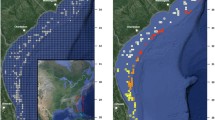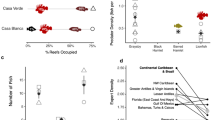Abstract
Indo-Pacific lionfishes (Pterois volitans/miles) have undergone rapid population growth and reached extremely high densities in parts of the invaded Atlantic. However, their long-term population trends in areas without active management programs are unknown. Since 2005, we have monitored lionfish abundance in the Exuma Cays of the central Bahamas on 64 reefs ranging in size from 1 to 4000 m2. Lionfish densities increased from the first sighting in 2005 through 2009, leveled off between 2010 and 2011, and then began to decrease. By 2015, densities had noticeably declined on most of these reefs, despite a lack of culling or fishing efforts in this part of The Bahamas. There was no consistent change in lionfish size structure through time. We discuss possible causes of the decline, including reductions in larval supply or survival, hurricanes, interactions with native species, and intraspecific interactions. Further studies are required to determine whether the declines will persist. In the meantime, we recommend that managers continue efforts to control invasive lionfish abundances locally.



Similar content being viewed by others
References
Albins MA (2013) Effects of invasive Pacific red lionfish Pterois volitans versus a native predator on Bahamian coral-reef fish communities. Biol Invasions 15:29–43
Albins M (2015) Invasive Pacific lionfish Pterois volitans reduce abundance and species richness of native Bahamian coral-reef fishes. Mar Ecol Prog Ser 522:231–243
Albins MA, Hixon MA (2008) Invasive Indo-Pacific lionfish Pterois volitans reduce recruitment of Atlantic coral-reef fishes. Mar Ecol Prog Ser 367:233–238
Albins MA, Hixon MA (2013) Worst case scenario: potential long-term effects of invasive predatory lionfish (Pterois volitans) on Atlantic and Caribbean coral-reef communities. Environ Biol Fishes 96:1151–1157
Barbour AB, Allen MS, Frazer TK, Sherman KD (2011) Evaluating the potential efficacy of invasive lionfish (Pterois volitans) removals. PLoS One 6:e19666
Bates D, Maechler M, Bolker B, Walker S (2014) lme4: linear mixed-effects models using Eigen and S4. R Package Version 11-7
Bates D, Maechler M, Bolker B, Walker S (2015). Fitting linear mixed-effects models using lme4. J Stat Softw 67:1–48
Beets J, Hixon MA (1994) Distribution, persistence, and growth of groupers (Pisces: Serranidae) on artificial and natural patch reefs in the Virgin Islands. Bull Mar Sci 55:470–483
Benkwitt CE (2013) Density-dependent growth in invasive lionfish (Pterois volitans). PLoS One 8:e66995
Benkwitt CE (2015) Non-linear effects of invasive lionfish density on native coral-reef fish communities. Biol Invasions 17:1383–1395
Benkwitt CE (2016) Central-place foraging and ecological effects of an invasive predator across multiple habitats. Ecology 97:2729–2739
Bøhn T, Terje Sandlund O, Amundsen PA, Primicerio R (2004) Rapidly changing life history during invasion. Oikos 106:138–150
Carr MH, Hixon MA (1997) Artificial reefs: the importance of comparisons with natural reefs. Fisheries 22:28–33
Côté IM, Green SJ, Hixon MA (2013a) Predatory fish invaders: insights from Indo-Pacific lionfish in the western Atlantic and Caribbean. Biol Conserv 164:50–61
Côté I, Green S, Morris J, Akins J, Steinke D (2013b) Diet richness of invasive Indo-Pacific lionfish revealed by DNA barcoding. Mar Ecol Prog Ser 472:249–256
Dahl KA, Patterson WF (2014) Habitat-specific density and diet of rapidly expanding invasive red lionfish, Pterois volitans, populations in the northern Gulf of Mexico. PLoS One 9:e105852
Dahl KA, Patterson WF, Snyder RA (2016) Experimental assessment of lionfish removals to mitigate reef fish community shifts on northern Gulf of Mexico artificial reefs. Mar Ecol Prog Ser 558:207–221
de León R, Vane K, Bertuol P, Chamberland VC, Simal F, Imms E, Vermeij MJA (2013) Effectiveness of lionfish removal efforts in the southern Caribbean. Endanger Species Res 22:175–182
Ellis RD, Faletti ME (2016) Native grouper indirectly ameliorates the negative effects of invasive lionfish. Mar Ecol Prog Ser 558:267–279
Frazer TK, Jacoby CA, Edwards MA, Barry SC, Manfrino CM (2012) Coping with the lionfish invasion: can targeted removals yield beneficial effects? Rev Fish Sci 20:185–191
Green SJ, Côté IM (2009) Record densities of Indo-Pacific lionfish on Bahamian coral reefs. Coral Reefs 28:107
Green SJ, Akins JL, Maljković A, Côté IM (2012) Invasive lionfish drive Atlantic coral reef fish declines. PloS One 7:e32596
Green SJ, Dulvy NK, Brooks AML, Akins JL, Cooper AB, Miller S, Côté IM (2014) Linking removal targets to the ecological effects of invaders: a predictive model and field test. Ecol Appl 24:1311–1322
Gutowsky LFG, Fox MG (2011) Occupation, body size and sex ratio of round goby (Neogobius melanostomus) in established and newly invaded areas of an Ontario river. Hydrobiologia 671:27–37
Hackerott S, Valdivia A, Green SJ, Côté IM, Cox CE, Akins L, Layman CA, Precht WF, Bruno JF (2013) Native predators do not influence invasion success of Pacific lionfish on Caribbean reefs. PLoS One 8:e68259
Ingeman K, Webster M (2015) Native prey mortality increases but remains density dependent following lionfish invasion. Mar Ecol Prog Ser 531:241–252
Johnston MW, Purkis SJ (2015) A coordinated and sustained international strategy is required to turn the tide on the Atlantic lionfish invasion. Mar Ecol Prog Ser 533:219–235
Kindinger TL, Albins MA (2017) Consumptive and non-consumptive effects of an invasive marine predator on native coral-reef herbivores. Biol Invasions 19:131–146
Lesser MP, Slattery M (2011) Phase shift to algal dominated communities at mesophotic depths associated with lionfish (Pterois volitans) invasion on a Bahamian coral reef. Biol Invasions 13:1855–1868
Maljković A, Leeuwen TE, Cove SN (2008) Predation on the invasive red lionfish, Pterois volitans (Pisces: Scorpaenidae), by native groupers in the Bahamas. Coral Reefs 27:501
Morris JA, Shertzer KW, Rice JA (2010) A stage-based matrix population model of invasive lionfish with implications for control. Biol Invasions 13:7–12
O’Farrell S, Bearhop S, McGill RAR, Dahlgren CP, Brumbaugh DR, Mumby PJ (2014) Habitat and body size effects on the isotopic niche space of invasive lionfish and endangered Nassau grouper. Ecosphere 5:123
Phillips BL, Shine R (2005) The morphology, and hence impact, of an invasive species (the cane toad, Bufo marinus): changes with time since colonisation. Anim Conserv 8:407–413
Pusack TJ, Benkwitt CE, Cure K, Kindinger TL (2016) Invasive red lionfish (Pterois volitans) grow faster in the Atlantic Ocean than in their native Pacific range. Environ Biol Fishes 99:571–579
R Core Team (2013) R: a language and environment for statistical computing. R Foundation for Statistical Computing, Vienna
Raymond WW, Albins MA, Pusack TJ (2015) Competitive interactions for shelter between invasive Pacific red lionfish and native Nassau grouper. Environ Biol Fishes 98:57–65
Ruttenberg BI, Schofield PJ, Akins JL, Acosta A, Feeley MW, Blondeau J, Smith SG, Ault JS (2012) Rapid invasion of Indo-Pacific lionfishes (Pterois volitans and Pterois miles) in the Florida Keys, USA: evidence from multiple pre- and post-invasion data sets. Bull Mar Sci 88:1051–1059
Schofield PJ (2010) Update on geographic spread of invasive lionfishes (Pterois volitans [Linnaeus, 1758] and P. miles [Bennett, 1828]) in the western north Atlantic Ocean, Caribbean Sea and Gulf of Mexico. Aquat Invasions 5:S117–S122
Sellers AJ, Ruiz GM, Leung B, Torchin ME (2015) Regional variation in parasite species richness and abundance in the introduced range of the invasive lionfish, Pterois volitans. PLoS One 10:e0131075
Simberloff D, Gibbons L (2004) Now you see them, now you don’t!–population crashes of established introduced species. Biol Invasions 6:161–172
Stallings CD (2009) Fishery-independent data reveal negative effect of human population density on Caribbean predatory fish communities. PLoS One 4:e5333
Torchin ME, Mitchell CE (2004) Parasites, pathogens, and invasions by plants and animals. Front Ecol Environ 2:183–190
Tuttle LJ, Sikkel PC, Cure K, Hixon MA (2017) Parasite-mediated enemy release and low biotic resistance may facilitate invasion of Atlantic coral reefs by Pacific red lionfish (Pterois volitans). Biol Invasions 19:563–575
Valdez-Moreno M, Quintal-Lizama C, Gómez-Lozano R, del Carmen García-Rivas M (2012) Monitoring an alien invasion: DNA barcoding and the identification of lionfish and their prey on coral reefs of the Mexican Caribbean. PLoS One 7:e36636
Whitfield PE, Gardner T, Vives SP, Gilligan MR, Courtenay WR Jr, Ray GC, Hare JA (2002) Biological invasion of the Indo-Pacific lionfish Pterois volitans along the Atlantic coast of North America. Mar Ecol Prog Ser 235:289–297
Zuur AF, Ieno EN, Walker NJ, Saveliev AA, Smith GM (2009) Mixed effects models and extensions in ecology with R. Springer, New York
Acknowledgements
This research was funded by the US National Science Foundation Grants OCE 05-50709, 08-51162 and 12-33027 awarded to M.A. Hixon. We thank the Perry Institute for Marine Science for providing field support until closing in 2012, as well as Dr. Pamela Reid and the Bahamas Marine EcoCentre who supported our field research in 2015. There were also numerous laboratory members, research assistants and interns who helped with data collection and management over the years.
Author information
Authors and Affiliations
Corresponding author
Additional information
Communicated by Biology Editor Dr. Andrew Hoey
Electronic supplementary material
Below is the link to the electronic supplementary material.
Rights and permissions
About this article
Cite this article
Benkwitt, C.E., Albins, M.A., Buch, K.L. et al. Is the lionfish invasion waning? Evidence from The Bahamas. Coral Reefs 36, 1255–1261 (2017). https://doi.org/10.1007/s00338-017-1620-7
Received:
Accepted:
Published:
Issue Date:
DOI: https://doi.org/10.1007/s00338-017-1620-7




